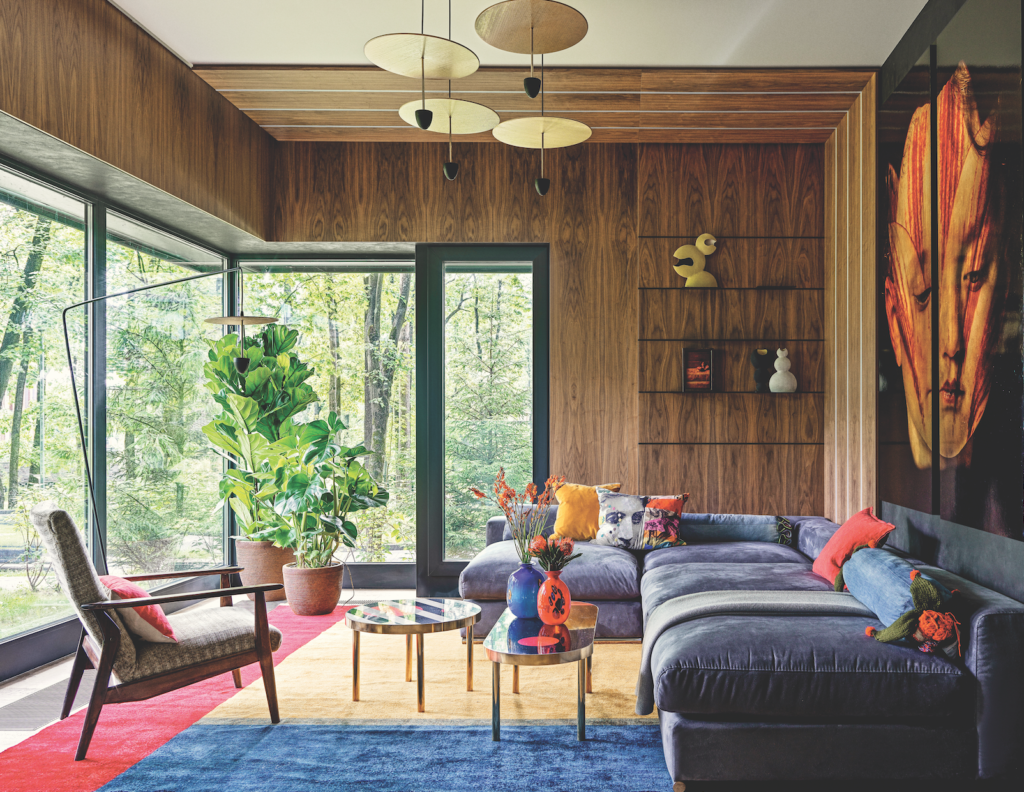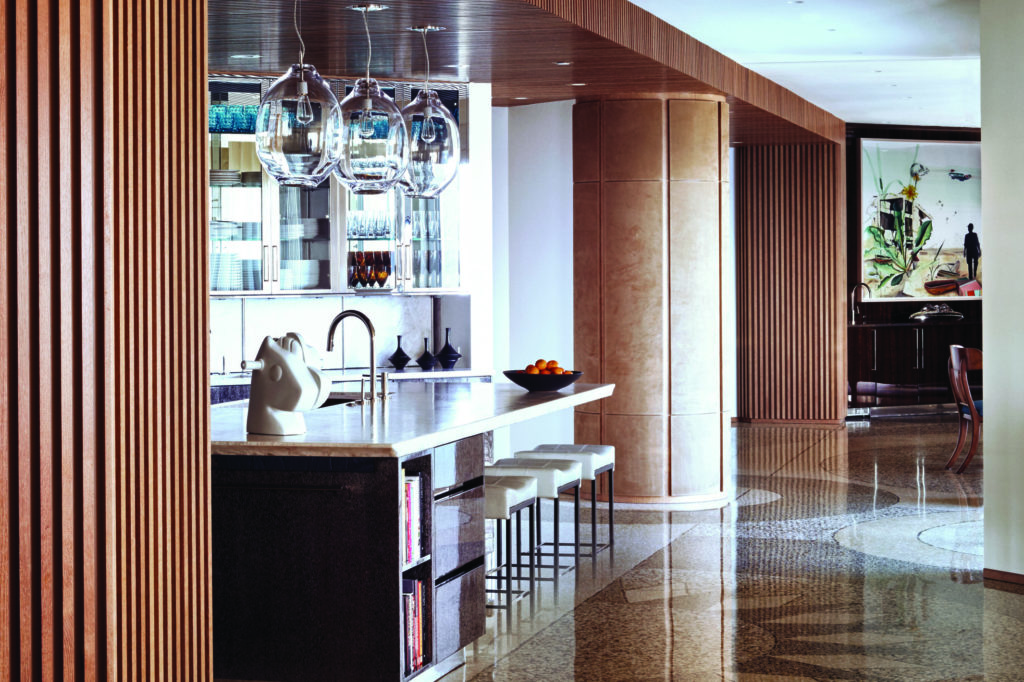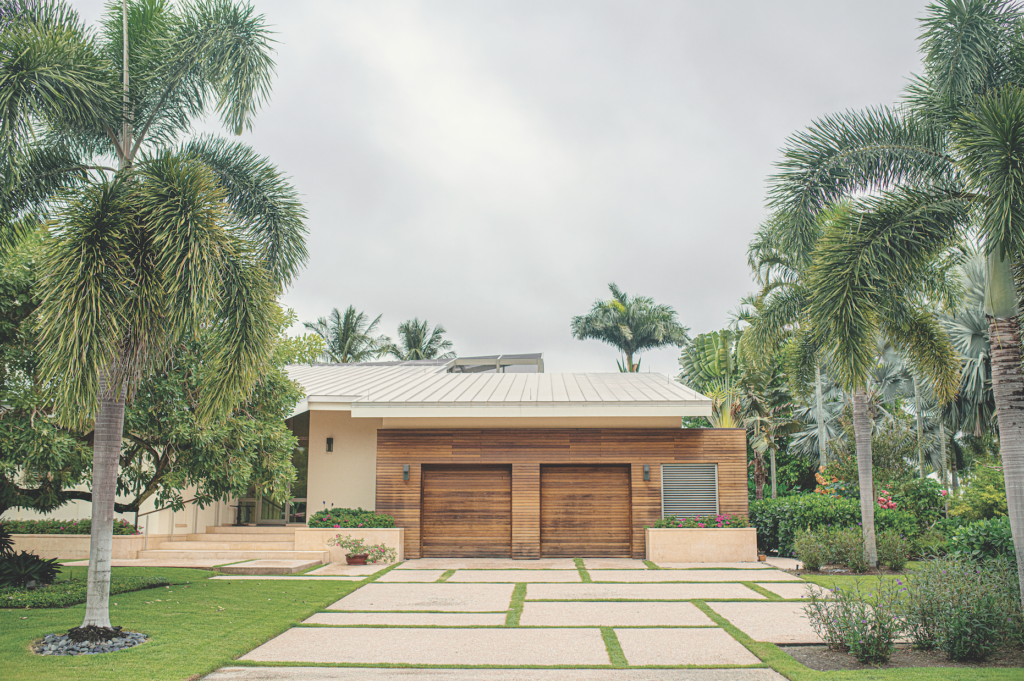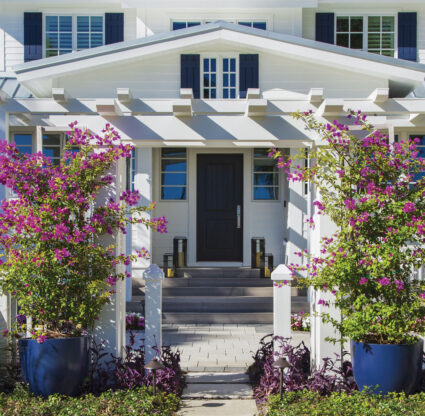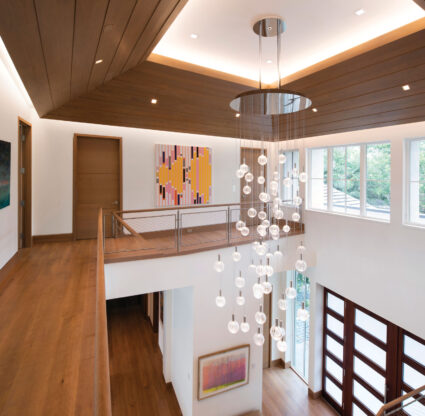After years of ascetic design trends defined by monochromatic palettes and cement- and glass-accented interiors, homeowners crave warmth. Architects and designers are happy to deliver, turning out inspired designs that blend the best of modernism with the organic qualities of wood. Gone are the laminate wood-paneled rooms, lacquered honey oak cabinetry and decorative corbels; instead, design now embraces the material’s natural beauty with minimalist lines and textured grains that add to the aesthetic.
“To me, wood is the thing that grounds a project,” architect Joyce Owens says. “We live in Southwest Florida, don’t you want nature to be part of who you are?” Lumber plays a starring role in most of her work. Several of her local projects use hardwood in the kitchen, where the grain subtly mirrors the geometry of the slab cabinets in purposeful repetitions. In one Naples project, cypress continues across the ceilings (inside and out onto the lanai) creating a sense of fluidity and a connection to the wooded lot. On Sanibel and Captiva, her team will use light stains to reflect the color of the sand outside. Even when a client asks for predominantly white interiors, she’ll use wood to add character.
Another modernist local firm, Hlevel Architecture incorporates local cypress and pine into most of its minimalist, eco-minded designs: Rows of cypress cladding cover otherwise stark facades; sleek floating staircases get walnut steps; and various types of wood are mixed-and-matched on ceilings, walls, furnishings and cabinets to add dimension. “We take a holistic approach, meaning we look at the environment and try to absorb what it’s telling us,” Hlevel’s Michaela Reiterer Henning says.
The revitalized interest is fortuitous, considering wood is a renewable material, and its increased use can help offset the home industry’s hefty carbon footprint (construction accounts for 38% of the global CO2 emissions). “It can be replanted and recycled,” Reiterer Henning says. “It’s also hypoallergenic, sound absorbent, and easy to clean and maintain.” And Pioneering projects, like the 25-story, mass timber Ascent high-rise in Milwaukee, prove the practical feasibility and aesthetic beauty of building with wood.
In Miami, Brillhart Architecture has received attention and awards for its cedar-clad Brillhart House. Recognizing most current-day Florida architecture relies on concrete, the firm created the home to show a more sustainable and authentically Floridian alternative. The glass-and-steel bungalow is surrounded by weather-resistant Western red cedar shutters that provide privacy and protection from the elements while allowing ample cross-ventilation and making the structure look perfectly at home among the trees. Inside, white oak floors and American cherry built-ins continue the eco-conscious theme.
Wood’s inherent connection to nature also bears philosophical considerations. The material is an integral part of biophilic design, the idea that enhancing a building’s connection to the outdoors and incorporating natural elements boosts wellbeing. “When you look at wood, it connects you to nature, relieves stress and brings warmth,” Reiterer Henning says.
And now, thanks to innovations and new technologies, architects and designers have plenty of room to play with wood. Troy Beasley, of Beasley & Henley Interior Design, is particularly interested in how wood is assembled (whether in unique configurations or paired with contrasting materials, like stone or glass) and cut to create texture. “Angles, rhomboid patterns, tambour panels, wood stripes with metal inserts, in-and-out pattern details—there are a lot of interesting things going on,” he says, adding that technology, like CNC routers (computer-controlled machines that can carve intricate patterns into the surface), expand the possibilities. For one Moroccan-inspired residence, his team is using the technology to outfit panels with intricate arabesque motifs—something that would have taken months to do by hand.
In other cases, architects may employ steam-bent wood—a process used in furniture making—to create curved facades, interior ceilings or walls that recall the ocean’s swell. Curves may also be carved into the wood, or planks can be artfully arranged in layers to create a wave effect.
More often, though, designs rely on time-honored principles—seamless, flat-faced cabinetry that recalls the simplicity of a solid slab or rail-thin slatted interior panels inspired by exterior cladding. For a Naples penthouse, Chicago architect and interior designer Suzanne Lovell drew inspiration from the homeowner’s appreciation of Japanese lacquer boxes for a white oak-slatted enclosure that runs the length of the condo, delineating the private and public spaces.
The designer often collaborates with millworkers, like Naples’ Thomas Riley Artisans’ Guild, to create wooden focal points. Ceiling-height, woodblock doors with invisible hinges, for instance, can double as solid wall coverings when the doors are closed. “We are seeing really cool applications of concealed doors with flush panels,” Matthew Riley, the guild’s CEO, says. “You may have a hallway with doors that lead to a closet, room or concealed sanctuary, but the hinging we use makes them undetectable.”
In the 21st century, millwork has generally gotten slimmer and sleeker. Panels and beams may be accented with LED lighting to accentuate shapes and create interesting shadows. Carlos Castro, founder of Bonita Springs’ Black Mangrove Woodworks, has noticed a growing demand for accent walls designed with fluted paneling, which incorporates popular midcentury elements but adds striking texture. He notes that with less equipment to store, entertainment centers have gotten leaner, too, with thin floating shelves (nothing deeper than 16 inches), low profiles and flush-mounted doors.
Castro notes that wood is best when presented as close to its natural state as possible—no espresso-colored stains, orangey varnishes or shiny veneers. “People are staying away from stains and using more natural tones,” he says. White oak and other light shades are popular now for the same reason white-coated interiors were favored: The clean look promotes a sense of calm and spaciousness—and it’s versatile.
But rich walnut and mahogany can be striking, too. To go even darker, designers may replace black-painted cabinets or walls with woods that get the torched, textured shou sugi ban treatment, as the ancient Japanese practice for preserving wood makes a comeback. In charring the surface to make it fire-retardant, dense and durable, the process reveals patterns in the grain that are as unique as a zebra’s stripes and a more natural, warmer finish than you’d get with paint. Along the same lines, Riley notes that homeowners are asking for nontoxic finishes. “We’ve seen a conscious shift to water-based finishing materials with little-to-no volatile organic compounds,” he says.
The ultimate aim is to get closer to nature, and wood—whether for the frame, internal structures, built-ins, furnishings or all of the above—provides a direct and stylish route.

